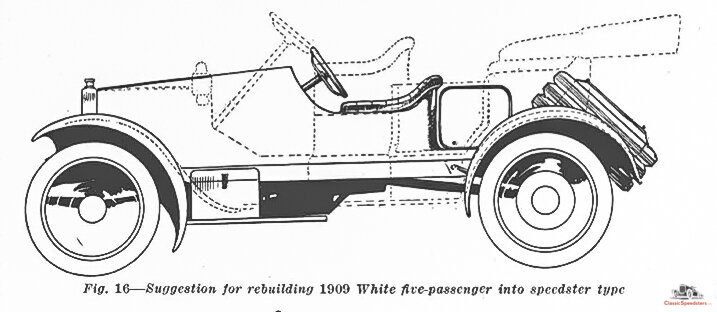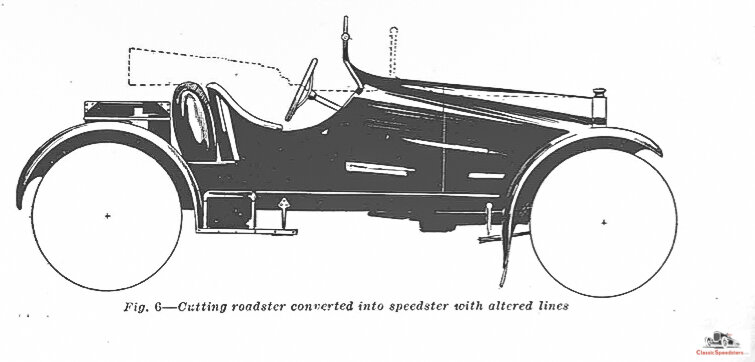Right Place, Right Time
Looking through some issues of Motor Age from 1915-19 brought forth some more reader-inspired ideas about cutdown and sport-bodied speedsters, the second one being a design trend that began in the mid-teens and actually persists to this day.
Ya gotta hand it to Motor Age – they had a finger on the pulse of Speedster Nation, judging by the number of readers sending in ideas and the variety of submissions.
Not sure what it represented, but this speedster sketch from 1918 had all of the needed pizazz elements of the time adorning it!
This speedster craze swelled into a phenomenon of the nineteen-teens period that went largely unnoticed in the daily press. This was understandable, as the world had fought a long and useless world war that ended in 1918, only then to be hammered by a worldwide flu pandemic that killed millions of people for the next two years.
Nevertheless, photos culled from family albums recorded that speedster fever was a virus that infected thousands of young folks hooked on adventure, speed and fun. A benevolent virus, mind you…
Imagine, Design, Act
To summarize from our previous posts on this subject, readers would submit (to Motor Age) photos of their projects, sketches of what they were considering, or just requests for an illustrator to sketch out their proposal.
It would be awesome to unearth a photo of this speedster from R. Kincaid in 1918 - now that it’s 100 years later!
The speedster movement had two developmental eras going by 1915, one phasing in and one phasing out, and so the submissions reflected either of the two speedster types, depending on reader taste. In this episode, we’ll look at the sketches.
Classic Speedster Designs
The first generation of street speedsters were cutdowns that bore an uncanny resemblance to their track-dedicated siblings. For example, the 1911 Cino was a street speedster that resembled the Cino track racers that finished on podiums in 32 events out of 44 starts.
1911 Cino Semi-Racer
Or, there were street speedsters that also served as racers because their designs were so masterful and they were so stoutly built. These one-and-the-same vehicles could go straight to the track and probably win, such as a burly Stutz Bear Cat, which went head-to-head with Mercer and others for the laurels. For years.
1914 Stutz Bear-Cat, a.k.a. Bear Cat and Bearcat.
First decade racing fans saw exciting action at local tracks and were smitten. Cutdowns were all the rage, and this trend persisted well into the latter part of the second decade. No brand of automobile was immune to being transformed into a cutdown, as seen in the examples that follow.
Don Stewart from Indianapolis wrote in about recycling a ten year-old Flanders 20 five-passenger tourer to have “a simple cowl or no cowl, like the Stutz Bearcat, and not much metal work.” The artist rendering included a discussion of spacing the seat, clearance from the steering wheel, and other practical matters for the hobbyist to consider. The result was a speedster in classic first-gen cutdown style.
1910 E-M-F Speedster. Ironically, E-M-F produced a speedster in 1912.
By the early part of the second decade, speedsters were sprouting doors like their roadster siblings, but the rear deck was often left exposed. Such is the case for the White in the example requested by J.M. Cerceran of Nashville, who wrote:
“Give suggestion for cutting down a 1909 White 30 touring car, five passenger, two door. I want to make it into a roadster conforming to the popular sport models with gasoline tank on the rear and rack for tires.”
1909 White GA Speedster
In 1909 White had seen the light and was transitioning from its focus on steam-powered transport to the world of gasoline power. This 1909 was likely based on a four-cylinder model using a 110” wheelbase, and its style reflects the movement toward more passenger protection.
The Cutting was a handsome and well-built automobile from Jackson, Michigan whose main claim to fame was that it fielded a team in the 1911 and 1912 Indy 500 Sweepstakes. It went down in 1913 in that year’s recession, but Cutting’s lines and long wheelbase (120”) inspired R.E. Martin of St. Mary’s, Ontario, Canada to write “Would like suggestions and illustration for making a speedster out of a Cutting roadster…”
1913 Cutting Speedster
Although doorless, there is still more protection in the curving lip of the cowl. Plus, it looks classy!
As elegant as the above example looks, some readers just wanted old-school styling like the fan in Kalamazoo. He wrote:
“I have a 1914 Saxon in fine mechanical condition which I would like to rebuild into a light speedster. Publish a sketch similar to the Hupp 1916… (but) if you have a sketch for a Saxon which would be more simple to build but just as racy, publish instead…”
1917 Saxon Four Speedster
The Sport-Bodied Trend
The latter part of the second decade saw an onslaught of sport-bodied two-passenger cars, often called roadsters, runabouts, or speedsters, depending on how they were outfitted.
Motor Age saw this trend coming as well, and wrote about it in their May 19, 1919 issue:
“Formerly popular speedsters with exposed gas tanks and trunks on the rear are now considered antiquated in design. In its place has appeared the turtle back speedster. Some of these have the gas tank built into the turtle back and also have a special luggage carrying compartment.”
This can be seen in a reader-requested design using a 1915 Studebaker.
1915 Studebaker SD Speedster
R. Smith of Galveston requested a similar treatment for a 1917 Hudson Super Six 7-passenger touring, and the staff sketchers turned out some fine details, including an external “mother-in law’s” seat!
1917 Hudson Super Six Speedster
The paired set of speedster sketches below indicate how a few details can drastically separate two sport-bodied speedsters of similar size, similar vintage, and similar engine capacity.
Two speedster sketches. Studebakers were popular then.
And let’s not forget the venerable Ford Model T. Even that ugly duckling can be dressed up for the Kleig lights, as Lester Clingman from Le Mars, Iowa found out when he requested a sketch from staff at Motor Age in 1918:
“Publish a sport roadster body for a Ford chassis. Also, are wire wheels good for long trips, and are they any good for all kinds of roads and weather?” Yes, of course, Lester!
1918 Ford Model T Speedster (Let’s hope that Lester carried this design through to completion)
That old Model T just needed a little love from a sketch artist to dress it out!
Next edition, we’ll look at actual owner-built speedsters from the photographs that they shared. Inspiration for the ages!
See you then…
< & >
Click on the icon on the left to share this post. Please subscribe using the subscription box on the right to receive a message about when the next post comes out. And comments are always welcome. Leave one below!













